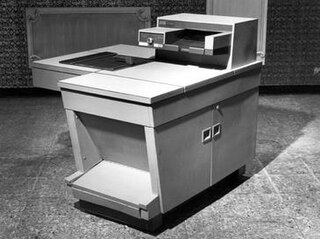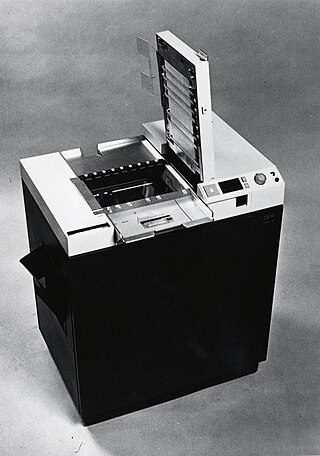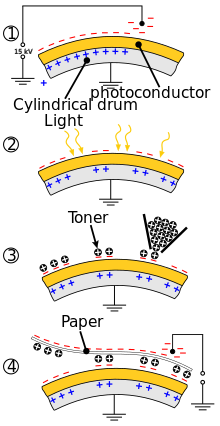
A mimeograph machine was a low-cost duplicating machine that worked by forcing ink through a stencil onto paper. The process was called mimeography, and a copy made by the process was a mimeograph.

Xerox Holdings Corporation is an American corporation that sells print and digital document products and services in more than 160 countries. Xerox is headquartered in Norwalk, Connecticut, though it is incorporated in New York with its largest population of employees based around Rochester, New York, the area in which the company was founded. The company purchased Affiliated Computer Services for $6.4 billion in early 2010. As a large developed company, it is consistently placed in the list of Fortune 500 companies.

Laser printing is an electrostatic digital printing process. It produces high-quality text and graphics by repeatedly passing a laser beam back and forth over a negatively charged cylinder called a "drum" to define a differentially charged image. The drum then selectively collects electrically charged powdered ink (toner), and transfers the image to paper, which is then heated to permanently fuse the text, imagery, or both, to the paper. As with digital photocopiers, laser printers employ a xerographic printing process. Laser printing differs from traditional xerography as implemented in analog photocopiers in that in the latter, the image is formed by reflecting light off an existing document onto the exposed drum.

A blueprint is a reproduction of a technical drawing or engineering drawing using a contact print process on light-sensitive sheets introduced by Sir John Herschel in 1842. The process allowed rapid and accurate production of an unlimited number of copies. It was widely used for over a century for the reproduction of specification drawings used in construction and industry. Blueprints were characterized by white lines on a blue background, a negative of the original. Color or shades of grey could not be reproduced.
Xerox art is an art form that began in the 1960s. Prints are created by putting objects on the glass, or platen, of a copying machine and by pressing "start" to produce an image. If the object is not flat, or the cover does not totally cover the object, or the object is moved, the resulting image is distorted in some way. The curvature of the object, the amount of light that reaches the image surface, and the distance of the cover from the glass, all affect the final image. Often, with proper manipulation, rather ghostly images can be made. Basic techniques include: Direct Imaging, the copying of items placed on the platen ; Still Life Collage, a variation of direct imaging with items placed on the platen in a collage format focused on what is in the foreground/background; Overprinting, the technique of constructing layers of information, one over the previous, by printing onto the same sheet of paper more than once; Copy Overlay, a technique of working with or interfering in the color separation mechanism of a color copier; Colorizing, vary color density and hue by adjusting the exposure and color balance controls; Degeneration is a copy of a copy degrading the image as successive copies are made; Copy Motion, the creation of effects by moving an item or image on the platen during the scanning process. Each machine also creates different effects.
Chester Floyd Carlson was an American physicist, inventor, and patent attorney born in Seattle, Washington.

Xerography is a dry photocopying technique. Originally called electrophotography, it was renamed xerography—from the Greek roots ξηρόςxeros, meaning "dry" and -γραφία-graphia, meaning "writing"—to emphasize that unlike reproduction techniques then in use such as cyanotype, the process of xerography used no liquid chemicals.

The EURion constellation is a pattern of symbols incorporated into a number of secure documents such as banknotes, checks, and ownership title certificates designs worldwide since about 1996. It is added to help imaging software detect the presence of such a document in a digital image. Such software can then block the user from reproducing banknotes to prevent counterfeiting using colour photocopiers.
An electrofax was a type of fax. It involved electrostatic printer and copier technology, where an image was formed directly on the paper, instead of first on a drum, then transferred to paper, as it would be in xerography. It was used in the United States from the 1950s through the 1980s.

The Xerox 914 was the first successful commercial plain paper copier. Introduced in 1959 by the Haloid/Xerox company, it revolutionized the document-copying industry. The culmination of inventor Chester Carlson's work on the xerographic process, the 914 was fast and economical. The copier was introduced to the public on September 16, 1959, in a demonstration at the Sherry-Netherland Hotel in New York, shown on live television.

Risograph is a brand of digital duplicators manufactured by the Riso Kagaku Corporation, that are designed mainly for high-volume photocopying and printing. It was released in Japan in 1980. It is sometimes called a printer-duplicator, as newer models can be used as a network printer as well as a stand-alone duplicator. When printing or copying many duplicates of the same content, it is typically far less expensive per page than a conventional photocopier, laser printer, or inkjet printer.

The Photostat machine, or Photostat, was an early projection photocopier created in the decade of the 1900s by the Commercial Camera Company, which became the Photostat Corporation. The "Photostat" name, which was originally a trademark of the company, became genericized, and was often used to refer to similar machines produced by the RetinalGraph Company or to any copy made by any such machine.
Robert W. Gundlach was an American physicist. He is most noted for his prolific contributions to the field of xerography, specifically the development of the modern photocopier. Gundlach helped transform the Haloid Company, a small photographic firm, into the thriving Xerox Corporation. Over the course of his 42-year career with the company, he contributed over 155 patents, making photocopying technology more affordable and practical. In 1966 Gundlach was named Xerox's first Research Fellow, the highest non-managerial that could be achieved by a Xerox scientist. After his retirement in 1995, he was granted several patents associated with his hobbies, including a snow-making system and a special backpack.

The IBM 3800 is a discontinued laser printer designed and manufactured by IBM. It was the first commercially available laser printer. It was a continuous form laser printer, meaning that it printed onto a continuous long sheet of paper.
Louise Odes Neaderland is an American photographer, printmaker, book artist and founder of the International Society of Copier Artists (I.S.C.A.) and the I.S.C.A. Quarterly, a collaborative mail, book art, and copy art publication. She was the organizer of ISCAGRAPHICS, a traveling exhibition of xerographic art.
Photoconductive polymers absorb electromagnetic radiation and produce an increase of electrical conductivity. Photoconductive polymers have been used in a wide variety of technical applications such as Xerography (electrophotography) and laser printing. Electrical conductivity is usually very small in organic compounds. Conductive polymers usually have large electrical conductivity. Photoconductive polymer is a smart material based on conductive polymer, and the electrical conductivity can be controlled by the amount of radiation.

A Machine Identification Code (MIC), also known as printer steganography, yellow dots, tracking dots or secret dots, is a digital watermark which certain color laser printers and copiers leave on every printed page, allowing identification of the device which was used to print a document and giving clues to the originator. Developed by Xerox and Canon in the mid-1980s, its existence became public only in 2004. In 2018, scientists developed privacy software to anonymize prints in order to support whistleblowers publishing their work.

Klaus Urbons is a German photographer and xerography printmaker. He is a pioneer and leading figure of copy art in Germany and not only. He founded the Museum für Fotokopie, and is the author and translator of books on the history of Copy Art and photocopiers, as well as a curator and a collector.

IBM Office Products Division (OPD) manufactured and sold copier equipment and supplies from 1970 till IBM withdrew from the copier market in 1988. IBM's decision to compete in this market resulted in the first commercial use of an organic photoconductor now widely used in most photocopiers. It is often held up as an example of a corporate u-turn, where a company rejects a technology and then adopts it. It showed that despite the size of IBM's sales and engineering organisations, this did not guarantee success in every market it chose to compete in. The development effort that resulted in the IBM Copier helped in the development of IBMs first laser printer, the IBM 3800.`
The Xerox 2700 is a discontinued monochrome laser printer from Xerox Corporation. The 2700 was announced in March, 1982, and can print up to 12 pages per minute (PPM), one-sided, on standard A4 or Letter cut-sheet paper. It occupies 5 square feet (0.46 m2) of floor space, and cost $18,995. The 2700 is rated for a print volume of 15,000 pages per month, although some users got up to 100,000 pages.















